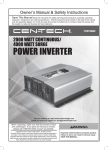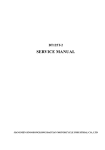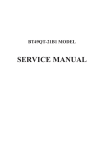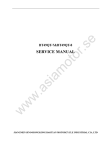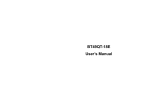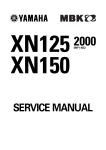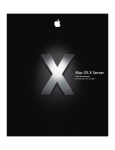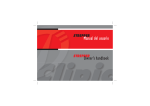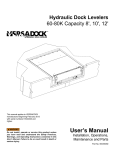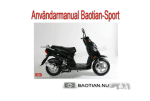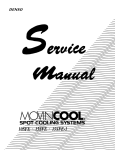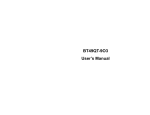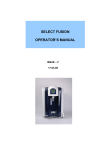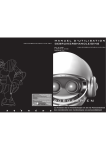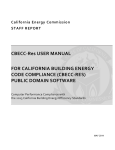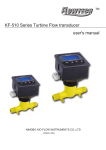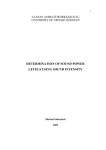Download SERVICE MANUAL
Transcript
BT49QT-28 MODEL SERVICE MANUAL CONTENTS CHAPTER ONE MAINTENANCE OF THE MOTORCYCLE Ⅰ. ITEMS OF MAINTENANCE 1 Ⅱ. PERIODIC MAINTENANCE SCHEDULE AND MAINTENANCE LOCATIONS 1 Ⅲ. MAINTENANCE SPECIFICATIONS 4 Ⅳ. THROTTLE ACTUATION INSPECTION 5 Ⅴ. AIR FILTER INSPECTION AND CLEANING 6 Ⅵ. BRAKE BLOCKS INSPECTION 6 Ⅶ. BRAKE SYSTEM INSPECTION, ADJUSTMENT AND REPLACEMENT 7 Ⅷ. FRONT AND REAR SHOCK ABSORBER INSPECTION 8 Ⅸ. FRONT WHEEL AND REAR WHEEL INSPECTION 9 Ⅹ. STEERING STEM INSPECTION CHAPTER TWO 10 MAINTENANCE INFORMATION Ⅰ. FRAME NUMBER AND ENGINE NUMBER LOCATION 11 Ⅱ. PRECAUTIONS IN OPERATION 11 Ⅲ. SPECIFIED TORQUES 12 Ⅳ. TOOLS 14 CHAPTER THREE ENGINE TROUBLESHOOTING Ⅰ. DISSEMBLING AND INSPECTING AIRINLETHOUSING, AIR FOIL 18 Ⅱ. DISSEMBLING AND INSPECTING CYLINDER HEAD HOOD 18 Ⅲ. DISSEMBLING AND INSPECTING CYLINDER HEAD AND VALVE 18 Ⅳ. DISSEMBLING AND INSPECTING CYLINDER AND PISTON 20 Ⅴ. DISSEMBLING AND INSPECTING KICK STARTER 22 Ⅵ. DISSEMBLING AND INSPECTING STEPLESS TRANSMISSION SYSTEM 23 Ⅶ. DISSEMBLING AND INSPECTING ELECTRIC STARTER 25 Ⅷ. DISSEMBLING AND INSPECTING MAGNETO AND ELECTRIC FITTINGS 27 Ⅸ. DISSEMBLING AND INSPECTING CRANKCASE AND CRANKSHAFT 31 Ⅹ. DISSEMBLING AND INSPECTING CHAMCHAIN AND TENSIONER 33 Ⅺ. DISSEMBLING AND INSPECTING LUBRICATING SYSTEM 33 Ⅻ. DISSEMBLING AND INSPECTING REAR TRANSIMISSION 35 ⅩⅢ. DISSEMBLING AND INSPECTING CARBURETOR 36 CHAPTER FOUR BODY TROUBLESHOOTING SECTION ONE BODY COMMON MALFUNCTION AND TROUBLE DETECTION 40 SECTION TWO DETAILED DESCRIPTIONS OF BODY PARTS MALFUNCTION Ⅰ. FRONT WHEEL SERVICE 43 Ⅱ. FRONT BRAKE SERVICE (DISK BRAKE ) 45 Ⅲ. FRONT SHOCK ABSORBER SERVICE 48 Ⅳ. FRONT FORK SERVICE 48 Ⅴ. HANDLEBAR SERVICE 50 Ⅵ. REAR WHEEL SERVICE 51 Ⅶ. REAR BRAKE SERVICE (DISK BRAKE) 52 Ⅷ. REAR SHOCK ABSORBER SERVICE 53 Ⅸ. COOLANT SYSTEM 53 CHAPTER FIVE SECTION ONE SECTION TWO ELECTRIC PART TROUBLESHOOTING ELECTRIC PART COMMON TROUBLES AND TROUBLE DETECTION 54 DETAILED DESCRIPTIONS OF ELECTRIC ASSEMBLIES AND PARTS SERVICE 56 Ⅰ. PRECAUTIONS IN ELECTRIC CIRCUIT SERVICE 56 Ⅱ. POWER CHARGING SYSTEM SERVICE 56 Ⅲ. IGNITION SYSTEM SERVICE 62 Ⅳ. ELECTRIC STARTING SYSTEM SERVICE 68 Ⅴ. LIGHTING AND SIGNAL SYSTEM SERVICE 69 Ⅵ. CIRCUIT DIAGRAM 74 SUMMARY This 2-stroke scooter BT49QT-28 is with low weight, enough power, low oil consumption and good operating performance. This manual is for maintenance men to repair and maintain BT49QT-28 and it is also useful when maintain other models. This manual holds the latest technical information. We reserve the right to amend the data, instructions and specifications without advice. The technical specifications of BT49QT-28: Size and weight: Length×width×height 1880×700×1200 Unloading weight 96kg Wheelbase 1300 Max. laden mass 249 kg Fuel tank capacity 4.5±0.5L Max. speed 45Km/h Front tire pressure Rear tire pressure 250KPa 250KPa Engine: Type 1E40QMA Lubricate method Pressure spray Stroke 2 Lubricant brand SAE15W/40SF Bore ×stroke 40.0mm×39.2mm Gasoline brand 90# or above Cylinder capacity 49cm3 Clutch type Automatic acentric Compression ratio 7.5±0.1:1 Transmission type Nonpolar 4.9/6500 Starting method Electric/kick starting 3.52/7000 Ignition method CDI 1700±100 Cooling system Forced air-cooled Battery 12V 6Ah Turning signal light 10W,12V Headlight 35/35W,12V Position light 5W,12V Taillight/brake light 5/21W,12V Fuse specification 10A Max torque: N.m/(r/min) Max power output: kw/(r/min) Idling speed: r/min Electric system: CHAPTER ONE MAINTENANCE OF THE MOTORCYCLE Ⅰ. ITEMS OF MAINTENANCE When the motorcycle is used, parts loose and mechanical wear inevitably occur to varied extents. Neglecting of timely maintenance not only reduces its mechanical function, economic performance, stability and durability, but also threatens the safety of the motorcycle and the rider. Correct and timely maintenance of the motorcycle is necessary. Items of maintenance refer to the parts and positions for maintenance. Different items of maintenance are affected in different intervals and in different manners. 1. Running-in Maintenance This is the maintenance at the end of the first 1000km and is an all-round inspection of motorcycle. A newly-bought motorcycle or a motorcycle fresh from an overhaul might be severely overheated as a result of severe friction between the moving parts which might be imperfect in finishing or fitting. Neglecting in use might lead to damage of the friction surfaces and might threaten the performance, and the service life of the motorcycle. Please observe the following points: Restrict the speed in speed range specified in the instruction manual. Restrict the load to 2/3 of the maximum load and ride in fairly good road conditions. Restrict the length of riding time to avoid long-time running of the engine. Replace engine oil at short intervals so that metal chips caused in the runningin period can be discharged. It is recommended to replace engine oil for 3 times during the running-in period. 2. Routine Maintenance Routine maintenance is the basis of all kinds of maintenances. It refers to the daily maintenance, including cleaning, inspecting and common troubleshooting. 3. Periodic Maintenance This maintenance is to restore normal performance of the motorcycle. The maintenance is classified into first-grade periodic technical maintenance and secondgrade periodic technical maintenance (also known as items of maintenance) according to different mileages. Generally speaking, a first-grade maintenance is effected after the initial 4000km and a second-grade maintenance is effected every 8000km. As the service time extends, maintenance intervals should be shortened accordingly. Ⅱ. PERIODIC MAINTENANCE SCHEDULE AND MAINTENANCE LOCATIONS After a period of using (one day, one month or half a year, for example) or a certain mileage (1000km, 4000km, 8000km, for example), an all-round maintenance operation should be effected, including comprehensive inspection, adjustment, tightening, lubrication, cleaning or replacement. The specific regulation made according to time intervals or mileages is known as maintenance interval. The motorcycle maintenance schedule is as follows. 1 1. Maintenance Schedule Maintenance Schedule time Mileage 1000km item Engine oil 1000 2000 3000 4000 5000 6000 7000 8000 9000 10000 11000 12000 New R 300km R R R R R R R R R R R Engine oil strainer C C Gasoline strainer Gear oil R Note 4 New R 300km Throttle play R A Carburetor Air filter Note 3, 4 A A A I I C I R Spark plug Brake system R R Clean every 3000km, replace when necessary I I I I I I Drive belt I I I I I I I Suspension I I I Tire I I I Steering rod bearing I Screws and bolts of parts I I I I Notes: 1. I: Inspect and when necessary, clean, lubricate, supplement, modify or replace. A: adjust; C: clean; R: replace; T: tighten. 2. Effect periodic maintenance according to the instructions in the user’s manual. 3. When the mileage exceeds the range specified in the schedule, repeat the maintenance. 4. In dusty or rainy conditions, inspection and replacement should be effected earlier. 5. In heavy load, long distance or rainy conditions, replacement should be effected earlier. 2 Ⅲ. MAINTENANCE SPECIFICATIONS The basic methods of motorcycle maintenance include inspection, adjustment, tightening, lubrication, cleaning, supplementing and replacement, which constitute the main elements of maintenance. 1. Inspection Inspection refers to basic inspecting operations in accordance with items and requirements specified in the user’s manual, including inspection with instruments or with eyes for abnormalities in machine parts, directly comparing related data and aligning with tools and gauges. 2. Adjustment Adjustment refers to inspection-based adjustment and rectification of some specified machine parts, including adjustment of machine part plays and rectification of misfittings and deformations so as to restore correct positions, forms and plays. 3. Tightening Tightening refers tightening of bolts, screws and nuts of machine parts with tools so as to avoid loosening of machine parts and to obtain specified tightening torques. 4. Cleaning Cleaning is needed where call for cleanliness and tidiness. Cleaning operations include all the means and measures taken to remove dust, contamination, metal chips, oily stains and carbon deposits that might lead to pipe clogging or reduction in motorcycle performance. Cleaning measures are washing, carbon deposit removing, rubbing, cleaning and clearing. 5. Lubrication In order to facilitate smooth and easy running of moving machine parts, including swinging parts, reciprocating parts, sliding parts and vibrating parts, to reduce scuffing, abrasion, deformation and to reduce friction, it is necessary to coat or spray these parts with a lubricant. Different lubricants and lubricating methods are required for different machine parts with different functions. Application of lubricants to machine parts is known as lubrication. 6. Replenishing, supplement and replacement These operations refer to addition of oil, lubricants, cooling water, electrolyte, fuel and replacement of damaged parts with new ones and replacement of denatured oils with new oils. 3 IV. THROTTLE ACTUATION INSPECTION Inspect throttle grip for easy and smooth movement. Inspect throttle free travel. Free travel: 2-6mm The main adjusting position is beside the carburetor. Remove rear store case inner cover. Adjust by loosening the fastening nut and turning the adjusting nut. Fine adjustment is effected on the side of the throttle grip. Effected adjustment is by removing the dust cover, loosening the tightening nut and turning the adjusting nut. 4 Ⅴ. AIR FILTER INSPECTION AND CLEANING After a certain mileage, dust and impurities will gather in air filter case and strainer, which will clog strainer pores and reduce inlet of air and thus lead to excessive concentration of mixed gas and reduce the performance of engine. That’s why the strainer must be cleaned every 2000-3000km and in dusty or rainy conditions strainer must be cleaned or replaced earlier. Remove 7 screws of air filter. Remove strainer cover. Take out the strainer. Immerse foam strainer in gasoline and wash it to remove dust and impurities by gripping and pressing. Press gasoline out of the foam. Soak the cleaned foam with engine oil, press out or throw out engine oil to leave it moist with oil. Mount. VI. BRAKE BLOCKS INSPECTION cleaning gripping gasoline soaking gripping ¢ Û Grip the brake lever and check the wear & tear indicator on the brake blocks. If the indicator nearly touched brake disc, the brake blocks must be replaced with new ¢ Ù ¢ Ú ¢ Ù--- wear & tear indicator ¢ Ú--- brake disc ¢ Û--- brake blocks ones. 5 VII. BRAKE SYSTEM INSPECTION, ADJUSTMENT AND REPLACEMENT 1. Front brake (disk brake) Remove the bolts linking brake caliper and front shock absorber. Remove brake caliper. * Do not pull brake lever when brake caliper is removed so as to prevent jamming of brake blocks. If brake blocks are jammed, pry it with screwdriver and push piston back into caliper. Brake Blocks Replacement: Brake blocks must be replaced when it is worn to the limit of use. * It is not necessary to remove brake oil pipe when replacing brake blocks. * Brake blocks must be replaced as a set. Remove the brake block pins by means of a hexagon wrench. Take out the old brake blocks and mount a set of new brake blocks. Effect mounting in an order reversed to that of dismounting. Brake Disc Inspection: Inspect brake disc thickness. Limit of use: 3.0mm Inspect brake disc angularity. Limit of use: 0.3mm 6 2. Rear Brake (disk brake) Remove the exhaust muffler. Remove the black dust cover. Remove the rear wheel nut. Remove the three mounting bolts of the rear wheel mounting base. Remove the rear wheel. Remove the bolts linking rear brake caliper and engine. Remove the rear brake caliper. * Do not pull brake lever when brake caliper is removed so as to prevent jamming of brake blocks. If brake blocks are jammed, pry it with screwdriver and push piston back into caliper. Brake Blocks Replacement: The same as the replacement of the front brake blocks. Brake Disc Inspection: The same as the inspection of the front brake disc. VIII. FRONT AND REAR SHOCK ABSORBER INSPECTION 1. Front Shock Absorber Tighten front brake lever, press front shock absorber up and down and inspect actuation. Inspect front shock absorber to see if there is leakage of oil and if there is damage or loosening. 7 2. Rear Shock Absorber Press rear shock absorber to inspect actuation. Inspect rear shock absorber to see if there is oil leakage and if there is damage or loosening in machine parts. Lift rear wheel, press rear wheel right and left to inspect if engine suspension lug buffer bush is loose. IX. FRONT WHEEL AND REAR WHEEL INSPECTION Wheel Rim Inspection: Inspect wheel rim, remove rust stains and rubber chips. Deformation and fissures are causes of air leakage. Do not use wheel rims in the following cases: Bruise of wheel rim face contacting tire bead ring exceeds 0.5mm in depth and 1.0mm in width. Tire Inspection: Inspect if there is fissure or iron nail in the tire. In one of the following conditions, tires must be replaced instead of repair. Puncture of tire by a foreigner matter 6mm in diameter or tire fissure. Layered tire. Chunking of tread Damaged tire bead Broken tire bead or other tire bead damages Broken tire cord Damage due to forced dismounting Fissure extending to frame Abnormal inner lining Tire groove wear: front wheel < 0.8mm, rear wheel < 0.8mm. Punctured or otherwise damaged tire flank 8 Inspect tire pressure by means of a tire pressure gauge * Tire pressure should be inspected when the motorcycle is in a cold state. Specified pressure Unit: KPa Front tire 250 Rear tire 250 Tire Specifications: Front tire 130/60-13 Rear tire 130/60-13 Inspect if front wheel nut is loose. Inspect if rear wheel nut is loose. If loose, tighten them to specified torques. Torques: front wheel nut 60N·m rear wheel nut 120N·m X. STEERING STEM INSPECTION Swing handlebar right and left to see if there is interference such as wire or other things. Turn front wheel to see that handlebar is easy in operation. In case of any difficulty in operation, inspect steering stem bearing assembly. 9 CHAPTER TWO MAINTENANCE INFORMATION I. FRAME NUMBER AND ENGINE NUMBER LOCATION II. PRECAUTIONS IN OPERATION Removed washers, 0-rings, elastic retaining rings and split pins must be replaced with new ones. When mounting bolts, nuts and screws, proceed from trial tightening, from larger diameters to smaller diameters and inner ones to outer ones in a diagonally order. Tighten them to specific torques. Parts and greases must be those made by our factory or recommended by our factory. Special operations must be effected with special tools or specified universal tools. Removed parts must be rubbed or cleaned before they are inspected or measured. They must be coated on the sliding faces before mounting. They must be greased at the specified positions with designated or equivalent greases. Parts must be tightened and their performances inspected at their positions when mounted. The battery’s negative terminal must be disconnected before operation. Make sure that tools such as wrenches are not in contact with the frame. At the completion of operations, reconfirm correct connections and fastenings. The positive terminal must be connected first in case of a removed battery. Connected terminals must be coated with lubricant. The terminals must be completely covered with caps. When a fuse is burnt, inspect the cause and replace the fuse with a fuse of equivalent capacity. At the completion of operation, completely cover terminals with caps. When removing connectors with locks, they must be unlocked before operation. When removing connectors, the connectors proper must be held instead of pulling their wires. Before connecting connectors, confirm that they are free from breakage, bending, over length or loosening. 10 Connectors must be inserted home. When connecting connectors with locks, confirm that their locks are fastened. Confirm that the wires are not loose. Confirm that connectors’ plastic sleeves completely cover the connectors without fail. Before connecting the connectors, confirm that their sleeves are free from breakage and their terminals are not oversized. Connector plugs must be fully inserted. Confirm that plastic sleeves completely cover the terminals. Plastic sleeves should not be placed with the open side up. Wire bunch bands should be fixed at the specified position of motorcycle frame. Wire clamps must correctly keep wires in place. Avoid welding stains of welded clamps when clamping wires. Wire bunches must be fixed away from turning or moving parts. Do not damage the covering of wire bunches. In case of wire bunch defects, remedy it with insulating bands. Wire bunches must not be covered with mounted parts. Do not twist or bend cables by force. Deformed or damaged cables would result in poor rotation or damage. Ⅲ. SPECIFIED TORQUES Torques at important positions and standard torques of other positions are as follows: SPECIFIED TORQUES Frame: Number Thread specification Torques: N·m Engine suspension lug mounting nut 2 M10 45 Engine mounting nut 1 M10 45 Front axle nut 1 M12 60 Rear axle nut 1 M16 120 Rear shock absorber upper mounting bolt 1 M10 40 Rear shock absorber lower mounting bolt 1 M8 25 Front shock absorber upper lock bolt 2 M10 40 Steering stem lock nut 1 M25 70 Handlebar mounting nut 1 M10 45 Upper bearing top 1 M25 2.5 Exhaust muffler connector nut 2 M6 12 Exhaust muffler mounting bolt 2 M8 35 Designations of tightening positions 11 Engine: Number Screw specification Torsion quadrature: N·m Cyclinder head bolt A 2 M7 9 Cyclinder head boltB 2 M7 9 Oil filter cap 1 M 30 15 Muffler flange fixing bolt 2 M6 9 Camshaft flange nut 4 M7 16~18 Valve adjusting bolt 2 M5 9 Chain tensioner bolt 1 Leaking oil bolt 2 M6 M8 10 10~12 Clutch outside wheel fixing bolt 1 M 10 40 Magneto rotor fixing bolt 1 M 10 40 Left crankshaft bolt 1 M 12 55 Spark plug 1 M 10 12 Oil pump driven gear bolt 1 M6 10 Chain tensioner bolt: M8*8 1 M8 6 Rear driving combination bolt 7 M8 20~22 Brake pad fixing bolt 1 M8 10 Cyclinder head fixing bolt 4 M4 3~5 Tighten part 12 Standard Torques: Designations Torques: N·m Bolt, nut M5 5 Bolt, nut M6 10 Bolt, nutM8 21.5 Bolt, nut M10 35 Bolt, nut M12 55 Screw M5 4 Screw M6 9 Flange bolt, nut M6 12 Flange bolt, nut M8 27 Flange bolt, nut M10 40 Ⅳ. Tools Tools Number Flywheel disassemble ware Z01 Valve adjusting gripe Z01 Spark plug spring guide Z03 13 CHAPTER FOUR SECTION ONE BODY TROUBLESHOOTING BODY COMMON TROUBLES AND TROUBLE DETECTION Body part common troubles and possible causes are as follows: Troubles Causes Handlebar rotation Over tightening of handlebar not easy (strenuous adjusting nut turning or unstable Steering stem over worn Details (reference) Refer to “Front Fork Service” tightness) Incorrect mounting of brake cable or tachometer cable Refer to “Handlebar Service”, “Front Fork Service” Remarkable deformation of steering stem due to outside impact Heavy steering stem turning Over tightening of steering stem top Refer to “Front Fork Service” ball bearing retainer Damaged or broken ball bearing Reduced tire air Imbalance of right and left shock Deflected steering stem absorbers Bent front fork Bent front tire, deflected tire Refer to “Front Wheel Service”, “Rear Wheel Service” Refer to “Front Shock Absorber Service” Refer to “Front Fork Service” Refer to “Front Wheel Service” Bent brake lever Air in hydraulic Disk brake failure Feeble brake lever device Leakage in hydraulic device Clogged hydraulic passage 14 Refer to “Brake System Inspection, Adjustment and Replacement, Front brake service or rear brake service” Chart continued Troubles Disk brake failure Causes Inadequate liquid Contaminated brake block and brake disc Bent or deformed brake disc Contaminated brake caliper Worn seal ring of brake caliper piston Feeble brake Viscous or worn lever brake caliper piston Inability of brake caliper normal sliding Worn main cylinder piston seal ring Viscous or worn main cylinder piston Contaminated main cylinder Clogged narrow brake system Clogged narrow liquid passage Viscous worn brake caliper Stiff brake Inability of brake lever caliper normal sliding Worn seal ring of brake caliper piston Viscous or worn main cylinder piston Contaminated brake block and brake disc Bent or deformed brake disc Resisted Inability of brake braking caliper normal sliding Wheel not adjusted straight 15 Details (reference) Refer to “Brake System Inspection, Adjustment and Replacement, Front brake service or rear brake service” Chart continued Troubles Causes Steering stem rotation not easy Bent shock absorber Deviation of motorcycle direction (inclining to roadside) Shock absorber oil leakage Bent front axle, incorrect wheel mounting Roundness error of wheel rim Deformation of wheel rim Inadequate tire pressure Deformed wheel rim Loose front wheel bearing Front wheel oscillation Poor tire Details (reference) Refer to “Front Fork Service” Refer to “Front Shock Absorber Service” Refer to “Front Wheel Service” Refer to “Front Wheel Service” Poor axle locking Soft front shock absorber Rear wheel oscillation Soft rear shock absorber Spring fatigue Refer to “Front Shock Absorber Service” Deformed wheel rim Poor wheel Refer to “Rear Wheel Service” Spring fatigue Refer to “Rear Shock Absorber Service” 16 SECTION TWO DETAILED DESCRIPTION OF BODY PARTS MALFUNCTION Precautions in Operation: Forced mounting or dismounting of body cover parts will cause damage to claws and slots of corresponding hoods. When mounting body cover parts, be sure to align the corresponding parts of hoods. When mounting body cover parts, avoid pressing wires, cables or pipes. I. FRONT WHEEL SERVICE Front Wheel Dismounting: Support the body bottom to lift front wheel. Remove the left and right rubber cap. Loosen and remove the front axle nut. Take out the front axle and remove transmission gearbox, front axle bush and the small axle bush. Remove front wheel. Remove brake disc mounting bolts. Remove brake disc. 17 Axle Bending Inspection Place axle on a V-seat and measure with a dial gauge. The dial gauge indicates a 1/2 bending value. Limit of use: Replace if >0.2mm. Wheel Rim Oscillation Inspection Measure oscillation value on a correcting bench. Limit of use: Replace if >2.0mm. Traverse direction: Replace if >2.0mm. Front Wheel Bearing Inspection Remove front wheel bearing and dust cover. Turn bearing inner race to inspect sliding. Replace it with a new one in case of no sliding or damage or loosening of outer race. Front Wheel Bearing Replacement Dismounting: Remove front wheel bearing by means of a bearing remover, take out spacer. Mounting: Apply grease to the bearing. Drive in left bearings. Mount spacer. Drive in right bearings. Bearings must be driven in parallel. Dust cover must be driven in with the face out. Apply grease to new dust cover lip. Mount front axle bush. 18 Front Wheel Mounting Mount brake disc, tighten brake disc mounting bolts. Torque: 27N·m Spread front axle with a thin film of grease. Mount front axle from left side. Mount in order small bush, left front shock absorber, front axle bush, front wheel, transmission gearbox, right front shock absorber, front axle nut and fasten it. Torque: 60N·m II. FRONT BRAKE SERVICE (DISK BRAKE) Brake Oil Replacing Prevent dust or water from entering brake system. Do not use brake oils of different specifications or impure brake oils. Prevent brake oil from dripping onto rubber, plastic or painted parts. Brake Oil Exhausting Place main cylinder at a level place, remove oil reservoir cover and diaphragm. Connect a hose to oil exhaust valve, loosen exhaust valve, grip and release brake lever till oil is exhausted. Brake Oil Replenishing Lock exhaust valve. Replenish oil reservoir with specified brake oil. ·It is not necessary to fill the oil reservoir to the full capacity. ·Brake oil for replenishing should be the same as original. The specification of brake oil is indicated on the reservoir cover. Place diaphragm. 19 Connect a transparent hose to exhaust valve. Grip brake lever fast and open exhaust valve 1/2 turn to let out air and lock exhaust valve. Repeat this operation till no bubbles are exhausted from brake oil passage. ·Do not release brake lever before exhaust valve is closed. At the completion of adjustment, replenish brake oil till oil is over the lower limit line of the oil reservoir. Mount diaphragm set and oil reservoir cover. Tighten oil reservoir cover bolt. Main Brake Oil Tank Dismounting and Mounting Dismounting Exhaust brake oil from front brake system. Take out brake switch plug from main cable. Remove bracket bolts from handlebar, Remove main cylinder. Remove brake oil pipe from main cylinder. ·Prevent brake oil from splashing to rubber, plastic or painted surfaces. Cover the abovementioned parts with a cloth. Remove brake light switch and brake lever. Remove retaining ring from main cylinder. ·Use special retaining ring remover when removing retaining ring. Remove piston cover, piston and spring. Clean oil reservoir and piston with pure brake oil. ·Do not effect cleaning with gasoline as it is corrosive to rubber parts. 20 Inspection Inspect for wear or ageing of main and auxiliary cups on pistons. Inspect for scratches and other damages on main cylinder and piston. Measure main cylinder bore. Measure the outside diameter of piston at the end of auxiliary cup. Mounting Apply pure brake oil to piston, main cup and auxiliary cup. Mount spring, piston, retaining ring and piston cap. ·Piston cup cannot be used inside out. Apply grease to brake lever axis pin. Mount brake lever and brake switch. Mount main cylinder, main cylinder bracket and lock them. Mount brake oil pipe. Connect brake light switch cable with switch. Replenish brake oil and exhaust air in brake system. Ⅲ. FRONT SHOCK ABSORBER SERVICE Dismounting Remove front brake calliper. Remove front fender mounting screws and remove front fender. Remove front wheel. Remove front bodycovering parts. Remove 2 pieces of bolts on the upper part of front shock absorber. Remove front shock absorber. Inspection Inspect if there is oil leakage in front shock absorber, if there is deformation of shock 21 absorber arm and if there is damage or loosening of any part. Mounting Mount front shock absorber on front fork and mount 2 bolts. Torque: upper bolt 40N·m. Mount bodycovering parts. Mount front wheel. Mount front fender and front brake caliper. Ⅳ. FRONT FORK SERVICE Dismounting Remove front body covering parts. Remove bolt, bush and nut. Remove handlebar. Remove steering stem set nut. Remove upper bearing cup, upper bearing top and bearing set. Support the body bottom to lift front wheel. Remove front shock absorber together with front wheel. Remove steering stem from head tube. The removing of the bottom bearing cup, bearing top and bearing set is the same as the removing of the upper series. Do not damage steering stem when removing bearing cup and bearing top. Clean opening parts of motorcycle body covering parts with cloth. 22 Inspection Inspect if there is slot or pit in bearing cup and bearing top. replacemented. If there is, effect upper bearing top upper bear ing cup bottom bearing top bottom bearing cup Inspect for completeness of bearing balls and if there is, effect replacement with new ball set ball set ones. Inspect for proper tightness of steering stem and if not, effect adjustment and fasten it. Inspect for correct position of bearing cup and bearing top and if not, effect correct mounting. Bearing Cup and Bearing Top Replacement Remove bearing cup and bearing top with special bearing cup and bearing top removers. Mounting Apply grease to bearing cup and bearing top at the bottom. Mount in order bottom bearing cup, bearing ball set, bottom bearing top on the bottom of steering stem. Pass steering stem through head tube. Apply grease to top bearing cup and bearing top. Mount in order upper bearing cup, bearing ball set and upper bearing top on the upper part of steering stem and fasten them. Torque: 15 N·m Turn front fork right and left to effect close contact of bearing balls. Loosen upper bearing top to torque 0 and fasten it. Torque: 2.5N·m Fix upper bearing top and tighten steering stem setting nut. Torque: 70N·m Turn front fork and confirm easy rotation without loosening. Lock set nut. Mount front shock absorber together with front wheel. Mount handlebar bolt, bush and nut. Mount handlebar. Mount front body covering parts. 23 Ⅴ. HANDLEBAR SERVICE Dismounting Remove covering parts of front part, rear part, upper cover and nether cover of handlebar. Remove the meter assy. Remove two bolts of rear brake main cylinder and remove brake main cylinder. Remove connectors of left handlebar switch. Remove 2 screws of left handlebar switch. Remove left handlebar switch. Remove left grip from handlebar. Remove two bolts of front brake maincylinder and remove brake main cylinder. Remove connectors of right handlebar switch. Remove 2 screws of right handlebar switch. Remove right handlebar switch. Remove throttle cable from throttle grip. Remove throttle grip from handlebar. Remove handlebar bolt, bush and nut from handlebar. Remove handlebar. · When removing left handlebar and throttle grip, remove contamination and grease from contacting face. 24 Mounting Mount nether cover of handlebar. Mount handlebar on steering stem guide tube, fit bush, setting bolt and nut. Torque: 45 N·m Mount upper cover of handlebar. Mount front and rear brake main cylinder. Mount left and right handlebar switch. Apply grease to throttle cable. Mount throttle grip and connect throttle cable. Mount left grip. Mount covering parts of front head cover and rear head cover. Confirm easy rotation of throttle grip. When mounting left grip, apply a thin film of adhesive to contacting face and then mount grip in a turning manner. Ⅵ. REAR WHEEL SERVICE Dismounting Remove 2 mounting bolts of rear wheel fender. Remove 2 mounting bolts and 2 mounting nuts of exhaust muffler and remove exhaust muffler. Remove the black dust cover. Remove the rear wheel nut. Remove the three mounting bolts of the rear wheel mounting base. Remove rear wheel. 25 Rear Wheel Oscillation Inspection Measure oscillation value on a correcting bench by means of micrometers. Limit of use: Longitudinal >2.0 mm Traverse >2.0 mm Mounting Mount rear brake disc and fasten the bolts. Torque: 27N·m Mount rear wheel in an order reversed to that of dismounting. Torque: 120N·m Mount rear shock absorber and fasten lower mounting bolt. Mount exhaust muffler. Fasten exhaust muffler connecting nuts and bolts. Torque: Exhaust muffler connecting nut: 12N·m Exhaust muffler mounting bolt: 35N·m Ⅶ. REAR BRAKE SERVICE (DISK BRAKE) Rear brake service is the same with front brake service. Ⅷ. REAR SHOCK ABSORBER SERVICE Dismounting Remove motorcycle body covering parts. Remove upper mounting bolt connecting rear shock absorber and motorcycle frame, lower mounting bolt connecting rear shock absorber and engine. Remove the rear shock absorber. 26 Inspection Inspect rear shock absorber oil seal for oil leakage, inspect buffer bar and spring for deformation and other parts for damage and loosening. Mounting Mount rear shock absorber. Torque: upper mounting bolt: 40N·m lower mounting bolt: 25N·m Mount motorcycle body covering parts. 27 CHAPTER FIVE ELECTRIC PART TROUBLESHOOTING SECTION ONE ELECTRIC PART COMMON TROUBLES AND TROUBLE DETECTION Troubles No power voltage Low power voltage Breakage of power current Poor power supply Sparkless spark plug Causes No electrolyte Whitened electrode plate Battery short circuit Battery discharge (overdischarging) Poor adjusting rectifier Disconnection of battery wire Broken fuse Poor power switch (main switch) Details Refer to “Power Supply System Service” Poor battery charging Poor contact Poor charging system Poor adjusting rectifier Poor contact of battery wire Poor contact in charging system Poor contact or short circuit in ignition system Poor contact or short circuit in light system Poor contact of wire or connector, wire breakage or short circuit Poor adjusting rectifier Poor AC generator Poor spark plug Poor contact, breakage or short circuit of wire Between AC generator and CDI Poor ignition coil switch Poor ignition coil Poor CDI Poor AC generator 28 Refer to “Ignition System Service” Troubles Causes Poor ignition coil Poor contact of wire or connector Poor main switch Poor ignition coil Poor contact of wire or connector Poor main switch Poor AC generator coil Poor fitting of stator Poor CDI Poor primary ignition loop Generator running not easy Poor secondary ignition loop Poor ignition timing Poor starting Feeble starting motor Burnt fuse Inadequate battery charging Poor main switch Poor starting motor switch Poor switches of front brake and rear brake Poor electric relay Poor contact or breakage of wire Poor starting motor Inadequate battery charging Poor contact of wire Jamming of starting motor or pinion by foreign matter Poor starting motor pinion Reversed running of starting motor Poor battery Engine refuses to start with starting motor running No switching between high beam Poor or damaged electric bulb and low beam when Poor switching switch hightlight HI or LO is operated Wire not mounted Breakage of wire Gasoline indicator Poor actuation of float failure Poor gasoline gauge Poor instrument Fluctuation of gasolin gauge Loose wire bunch Poor gasoline gauge Poor instrument 29 Details Refer to “Ignition System Service’ Refer to “Electric Starting System Service” Refer to “ Lighting and Signal System Service” SECTION TWO DETAILED DESCRIPTION OF ELECTRIC ASSEMBLIES AND PARTS SERVICE I. PRECAUTIONS IN ELECTRIC CIRCUIT SERVICE 1. Main switch must be set at position “OFF” before wires are connected or disconnected. 2. When connectors with locks are disconnected, locks must be pressed or lifted. 3. Connectors are classified into two kinds: connectors with press-off locks and connectors with lift-off locks. They must be distinguished in shape before they are disconnected. 4. When disconnecting storage battery, the negative terminal must be disconnected first. 5. When connecting storage battery, the positive terminal must be connected first. 6. At the completion of terminal connection, they must be greased. 7. At the completion of connection, every part should be inspected for correct connection, fastening and conductivity. 8. Wires of the same color are connected together; when wires of different colors are to be connected, they should be connected with wires with a sleeve of the same color near the terminal. 9. Connectors of the same color and the same number of wires should be connected. 10. When measuring terminal voltage and resistance with a gauge, the probe should be inserted from behind the connector. Waterproof connector tester should be inserted from the front of the terminal. II. POWER CHARGING SYSTEM SERVICE Troubles Inadequate battery charging (horn producing no sound, a low sound or an abnormal sound; starting motor does not run) Storage battery overcharging or over discharging Causes Adjusting rectifier failure Brake light is eternally on. Electric leakage of attached electric device or circuit Storage battery over discharging due to longterm storage. Storage battery over discharging due to frequent starting and short-distance riding. Storage battery has reached limit of use or poor storage battery (excessive self-discharging) Damaged rectifying part of voltage adjusting rectifier Damaged voltage adjusting part of voltage adjusting rectifier 30 1. Storage Battery Precautions in Using Storage Battery ○,1Do not effect the first starting of a new motorcycle by electric starter as a new storage battery has only 80% of full capacity. The difficulty in starting a new motorcycle often causes overdischarging of storage battery. ○,2MF storage battery must not be replenished with the seal removed. A new MF storage battery should not be replenished with common electrolyte. It should be replenished with the electrolyte supplied with the storage battery. ○,3 After a new storage battery is replenished with electrolyte, it must be kept still for at least 20-30 minutes before it is used. ○,4If, at the completion of electrolyte replenishing and after 20-30 minutes, voltage at the terminal is >12.5V, recharging is not necessary. Battery Dismounting Remove foot rest storage battery cover screw. Open the cover and take out storage battery. Remove negative wire and then positive wire. ● When removing positive terminal, tools should not contact motorcycle body, otherwise, short circuit shall occur, which causes spark that shall easily ignite gasoline and damage storage battery. Mounting is effected in an order reversed to that of dismounting. ● To prevent short circuit, please connect negativeterminal first before connecting positive terminal. Charging Condition (Open Circuit Voltage) Inspection Remove foot rest. Open storage battery cover and remove storage battery terminal. Measure voltage between storage battery terminals Fully charged: 13.1V Inadequately charged: 12.3V ● Effect inspection by means of a voltmeter. Charging Method Storage battery charging can be effected in the following way, but the best charging method is one with preset charging time and charging current. The charging method is as follows. Charging method Storage battery YTX5L-BS Storage terminal voltage 11.5V and below 0.4A 20 hours 11.5~12.8V 0.4A 5~10 hours 12.8V and above Charging not necessary 31 In the following cases, effect replenishing charging of new storage battery Case for replenishing Replenishing method Charge for 2-3 hours at the charging current value (standard current) indicated 0 ℃ and below in winter on storage battery cover. Stored in high-temperature and highStandard current (current indicated on humidity environment storage battery cover for charging) charging for15-20 hours Damaged or unsealed during storage (without “bo” sound when unsealed) Manufactured 1-2 years ago (date of production indicated on storage battery) When storage battery voltage is under 11.5V, a state of overdiacharging, inner resistance of storage battery might be very high and charging can not be effected at a common charging voltage (16~17V). In such a case, charging can be effected at a higher voltage by adjusting charging voltage to 25V (maximum) under the supervision of a ammeter. In 5 minutes when current reaches standard value, voltage must be adjusted back to standard value for continued charging. In case current does not change after 5 minutes, replace storage battery. Keep storage battery away from fire. Before starting charging or at the completion of charging, turn off charger switch first so as to prevent explosion due to spark at connecting positions. Charging must be effected on the basis of current time indicated on storage battery. In no case should quick charging be used except in emergent cases. Voltage measurement should be effected only 30 minutes after completion of charging. 32 Charging current: Standard: 0.6A Quick: 6.0A Charging time: Standard: 5~10 hours Quick : 30 minutes At completion of charging: Open circuit: 12.8V and above 2、Charging System Inspection Electric Leakage Inspection Remove earthing wire from storage battery, connect voltmeter between storage battery negative terminal and earthing wire. Inspect if there is short circuit with main switch plate at position OFF. Connect circuit tester positive terminal to storage battery wire and negative terminal to negative terminal of storage battery. In case of abnormality, inspect if there is short circuit in main switch or main wire. Charging Inspection Inspect by means of a circuit tester with storage battery fully charged. Mount fully charged storage battery on preheated Engine. Connect an ammeter between storage battery terminals.。 Remove main fuse and connect an ammeter between terminals. Connect engine to tachometer. Start engine, gradually raise its speed and measure limiting voltage and current. Limiting voltage/current: 14~15V (5000r/min) In case limiting voltage is not in specific range, inspect voltage adjusting rectifier.。 Lighting System Limiting Voltage Inspection Remove front cover. Set circuit tester at AC position. Limiting voltage: 13.l ±0.5V (5000r/min) In case limiting voltage is not in specific range, inspect voltage adjusting rectifier. 33 3. Voltage Adjusting Rectifier Troubles Causes Burnt bulb in lighting system Damaged voltage adjusting part of voltage adjusting rectifier Storage battery Damaged overcharging or voltage overdischarging adjusting part of voltage adjusting rectifier Inspection method Start engine and measure lighting coil voltage. In case voltage rises with the rise of engine speed, trouble exists. Start engine, measure charging voltage and charging current troubleshooting parameter Replace voltage adjusting rectifier Voltage: 812V Voltage: 11.1~16.8V Current: 0.5~0.51A Note 1. Normally, voltage does not rise much with the rise of engine speed. In case of remarkable risee of voltage with an engine speed of 5000r/min and a voltage of 40V, it is abnormal. Note 2. The voltage and current are closely related to the degree of storage battery charging. Meassred at full charging, the voltage is higher and current lower. 34 Main Wire Terminal Loop Inspection Remove front cover. Remove voltage adjusting rectifier plug 4P and measure conductivity between main wire terminals. Item (wire color) judgment Between storage (red) and motorcycle earthing With storage battery voltage Between earthing wire (green) and motorcycle With conductivity earthing Between lighting wire (yellow) and motorcycle With AC generator coil resistance earthing (remove resistor and automatic side starter plugs and inspect with lighting switch plate set at OFF. Between charging wire (white) and motorcycle With AC generator coil resistance earthing Voltage Adjusting Rectifier Inspection When main wires are confirmed correct, inspect for good contact of voltage adjusting rectifier and measure resistance between voltage adjusting rectifier terminals. During inspection, do not touch the metal part of circuit tester as human body resistance shall affect the accuracy of measurement readings. Inspect with a standard circuit tester. Consumption of dry battery in circuit tester shall affect measurement readings. In case of abnormality, inspect battery capacity. In case of abnormal resistance between terminals, replace voltage adjusting rectifier. 4. AC Generator Charging Coil Inspection of AC generator charging coil can be effected on engine. Remove AC generator connector 4P. Measure resistance between AC generator white wire and motorcycle earthing. Standard value: 0.2~1.0Ω(20℃) In case measured value exceeds standard value, replace AC generator coil. 6. AC Generator Lighting Coil Inspection of AC generator lighting coil can be effected on engine. Inspection Remove AC generator connector 4P. Measure resistance between AC generator yellow wire and motorcycle earthing。 Standard value: 0.1~0.8Ω(20℃) In case measured value exceeds standard value, replace AC coil. 35 III. IGNITION SYSTEM SERVICE Troubles Ignition coil voltage too low Intermittent voltage in ignition coil Causes (Inspect and judge from ○,1) ○,1 Inner resistance too low, inspect with a specified circuit tester. ○,2 Crankshaft speed too low (storage battery voltage too low, or starting rod too feeble when tread on) ○,3 Circuit tester interfered (normal case: repeated measured voltgage readings stay above standard). ○,4 Poor contact in ignition system wire ○,5 Poor ignition coil ○,6 Poor ignition and charging coils (measure maximum voltage) ○,7 Poor CDI (abnormal in ○,1~○,6 with sparkless spark plug). ○,1 Incorrect circuit tester connection ○,2 Poor main switch ○,3 Poor CDI connector ○,4 Breakage or poor contact of CDI earthing wire ○,5 Poor ignition and charging coils (measure maximum voltage) ○,6 Poor trigger coil (measure maximum voltage) ○,7 Poor contact of high-voltage wire. ○,8 Poor CDI (abnormal in ○,1~○,7 with sparkless spark plug) Sparkless spark plug with ○,1 Poor spark plug or leakage in secondary ignition normal voltage of ignition coil. coil ○,2 Poor ignition coil. Ignition and charging coil voltage too low ○,1 Inner resistance too low, measure with specified circuit tester ○,2 Crankshaft speed too low, (storage battery voltage too low, or starting rod too feeble when tread on) ○,3 Circuit tester interfered (normal value: repeated measurement values above reference value). ○,4 Poor ignition and charging coils (when ○,1~ ○,3are normal). Intermittent voltage of ○,1 Poor ignition coil 36 ignition and charging coils Troubles Trigger coil voltage too low Intermittent voltage of trigger coil ○,2 Poor ignition and charging coils Causes (Inspect and judge from ○,1) ○,1 Inner resistance too low, measuree with specified circuit tester. ○,2 Crankshaft speed too low (storage battery voltage too low or starting rod too feeble when tread on). ○,3 Circuit tester interfered (normal value: repeated measurement readings above reference value). ○,4 Poor trigger coil (when ○,1~○,3 are normal). ○,1 Poor ignition coil ○,2 Poor trigger coil 1. Precautions a) Trace ignition system troubles in order specified in trouble detection chart. b) The ignition system is an automatic electronic angulation device in CDI set, so it is not necessary to adjust ignition time. c) Disconnection, drooping or impact of ignition CDI sysstem is the cause of trouble. Dismounting should be effected with special care. d) Most of the causes of trouble are those of connectors and plugs. Before service, inspect connectors to ensure sound contact. e) Inspect for the correct heat value of spark plugs. Improper spark plugs are the main causes of ill running or burning of engine. f) Effect inspection of main switch according to the conductivity chart. g) Refer to dismounting instructions for AC generator and trigger coil dismounting. 2. Ignition System Inspection Note: In case of sparkless spark plug, inspect if there is any loosening or poor contact. As circuit testers are of many brands and different inner resistances, measurement readings might be different. Circuit tester output resistance should be above 10MΩ Connect high voltage distributor with circuit tester. 37 Ignition Primary Coil Voltage Remove spark plug as illustrated and mount a faultless spark plug. Connect spark plug with engine earthling. Note: Effect correct connection of wires and their measurements。 Cylinder compression pressure measurement is effected in normal condition (measure with spark plug fitted on cylinder head). Remove middle cover. Connect ignition coil wire. Distributor is connected between primary coil terminal (black-yellow) and motorcycle earthling. Start starting motor or tread on starting rod and measure ignition coil primary side maximum voltage。 Connecting method: positive terminal connected togreen wire and negative terminal connected to black/yellow wire. Minimum voltage: 95V and above. Note: When measuring voltage, do not touch any metalpart of the test bar so as to prevent electric shock. 38 Ignition and Charging Coil Note: Mount spark plug on cylinder head, inspect at normal compression pressure. Remove CDI set connector 6P, connect distributor between ignition and charging coil at wire terminal (black/red terminal) and green terminal. Actuate starting motor or tread on starting rod, measure ignition and charging coil maximum voltage. Connecting method: Positive terminal connected with black/red wire and negative terminal connected with green wire. Minimum voltage: 95V and above Note: When measuring voltage, do not touch any metal part of the test bar so as to prevent electric shock. In case measured CDI set terminal maximum voltage is abnormal, remove motorcycle right cover and AC generator connector. Connect ignition and charging coil (black/red). In case CDI set terminal voltage is abnormal and AC generator terminal voltage is normal, it indicates poor contact of connector or wire breakage. Abnormality at both ends indicates poor ignition and charging coils. Please refer to trouble detection chart for inspection. Trigger Coil Note: Mount spark plug on cylinder head, inspect at normal compression pressure. Remove CDI connector 6P, connect high-voltage distributor between trigger coil at wire terminal (blue/yellow terminal) and green terminal. Actuate electric starting motor or tread on starting rod, measure trigger coil maximum voltage. Connecting method: Positive terminal connected to blue/yellow wire, negative terminal connected to green wire. Minimum voltage: 1.7V and above. Note: * When measuring voltage, do not touch any metal part of the test bar so as to prevent electric shock. In case measured CDI set terminal maximum voltage is abnormal, remove motorcycle right cover and AC generator connector. Connect trigger coil (blue/yellow) with distributor. In case CDI set terminal voltage is abnormal and AC generator terminal voltage is normal, it indicates poor contact of connector or wire breakage. Abnormality at both ends indicates poor ignition and charging coils. Please refer to trouble detection chart for inspection. 39 3. CDI Check Troubles 1. Poor contact 2. Absence of high-voltage 3. Occasional misfire 4. Poor acceleration 5. Effective kick starting, elctronic starting failure 1. 2. 3. 4. 5. 6. Causes Damaged terminal, poor connecting or contact punctured or damaged diode punctured or damaged transistor punctured or damaged thyristor integrated circuit damaged capacitor or resistor Open storage battery cover. Remove CDI set, inspect ignition-related parts and wire terminals. Remove CDI set, inspect if there is connection loosening or corrosion. Inspection items Main switch Ignition and charging coils Trigger coil Primary ignition coil Secondary ignition coil Terminal Black/white-motorcycle earthing Black/red-motorcycle earthing Blue/yellow-motorcycle earthing Black/yellow-green Green-spark plug cover (not including spark plug cover) 4. Ignition Coil Dismounting Remove motorcycle cover. Remove spark plug cover. Remove spark plug cover. Remove ignition coil set bolt and ignition coil. Effect mounting in an order reserved to that of dismounting. Connect primary coil with black-yellow wire connected with black connector and green wire connected with green connector. 40 Main switch Conductive with main switch at OFF 400~800Ω 50~200Ω 0.21Ω±10% 3.1kΩ±10% Primary Coil Inspection Measure resistance between primary terminals. Standard value: 0.21Ω±10% (20℃) Resistance within standard value indicates good state. Resistance “∞” (infinity) indicates open circuit of coil. Replace coil. Secondary Coil Inspection Measure primary coil resistance between terminals. Standard value: 7~12kΩ (20℃) Resistance value: “∞”indicates breakage of wire in coil. Remove spark plug cover, measure resistance between wire at primary ignition coil side and negative terminal. Standard value: 3.1kΩ±10%(20℃) 5. Trigger Coil Inspection of trigger coil can be effected on engine. Remove motorcycle cover. Remove trigger coil wire connector. Measure resistance between engine side wire blue/yellow terminal and earthing.。 Standard value: 50~200Ω(20℃) In case measured value exceeds standard value,replace AC generator. 6. Ignition and Charging Coil It is not necessary to remove coil while coil inspecting. Remove ignition and charging coil wire connector. Remove ignition and charging coil wire Connector. Measure resistance between generator side black/red wire and motorcycle earthing. Standard value: 400~800Ω(20℃) In case measured value exceeds standard value, replace AC generator. 41 Ⅳ. ELECTRIC STARTING SYSTEM SERVICE Troubles Electric starting failure with normal circuit and normal starting motor rotation Starting relay failure without closing sound when started but with other electric circuits normal Causes One-way clutch spring fatigue or breakage Damaged brake switch Burnt starting relay Damaged starting switch Damaged CDI Other circuit failures Inadequate storage battery charging Poor contactor contact of starting relay Damaged motor, worn brush Circuit failure Idle speed too low Starting motor does not rotate with closing sound of starting relay when started and with other circuit systems normal Starting motor keeps running when starting switch is released Starting motor speed too low Inadequate storage battery Poor connection of wire Starting Relay Actuation Inspection Remove motorcycle cover. Main switch is set at ON. Inspect if there is a clicking sound when starting motor button is pressed. This sound indicates normality. In case there is no sound: Inspect starting relay voltage. Inspect starting relay earthing loop. Inspect starting relay actuation.。 Starting Relay Voltage Inspection Support the motorcycle with main stand and meassure voltage between starting relay connector green/yellow wire and earthing。 With main switch at position ON, pull brake Lever. Storage battery voltage should be within the specified range. In case there is no voltage at starting relay terminal, inspect conductivity of brake switch and wire. 42 Starting Relay Earthing Loop Inspection Remove starting relay connector. Inspect conductivity between wire connector terminal yellow/red wire and motorcycle earthing. Conductivity between terminal yellow/red wire and motorcycle earthing when starting button is pressed. Inspect conductivity of starting button and wire. Connect starting relay with storage battery, connect starting motor terminal with three-in-one meter. Connect fully charged storage battery between yellow wire/red wire and green wire/yellow wire. When storage battery voltage is introduced, conductivity between relay, storage battery, starting motor terminal should be normal. V. LIGHTING AND SIGNAL SYSTEM SERVICE Troubles Burnt bulb in lighting system Causes Partial damage of voltage adjusting rectifier Inadequate charging Flashing relay failure Damaged direction lights switch Circuit failure Burnt bulb or poor contact between bulb and bulb seat Breakage of earthing wire Short circuit of taillight Inadequate storage charging Wire failure Horn failure Fuel gauge failure Damaged oil level float All direction lights are off. One direction light is not on and one does not flash. When braking, all lighting lamps and direction lights are on but headlight Silent horn or horn sound too low No indication of fuel gauge 43 1.Headlight Adjustment and Dismounting Loosen headlight fastening bolt and turn headlight to adjust headlight beam. Remove headlight fastening bolt. Remove headlight cover. Remove headlight bulb. Mounting is effected in an order reversed to that of dismounting. (If want to change healight bulb, the bulb should be 12V,18W) 2.Front Direction Light Bulb Replacement Remove 2 plus screws. Remove direction light cover. Remove bulb. Effect mounting in an order reversed to that of dismounting. 3.Taillight and Rear Direction Light Taillight and Rear Direction Light Bulb Replacement Remove motorcycle guard cover. Remove taillight hood set screw. Removee taillight hood. Remove bulbs of taillight and direction light. Effect mounting in an order reversed to that of dismounting. 4. Main Switch Main Switch Conductivity Chart 44 Remove front head cover. Remove main switch wire connector. Inspect conductivity between connector terminals. 5. Horn Voltage supplied 10~ 14.5V <10A Current supplied 0~2A Horn condition No sound Location of trouble Horn 2~3A ≥3A No sound No sound Horn Horn ≥0A No sound Inadequate power Remove front head cover. Remove horn wire. Connect horn wire with storage battery. Horn sound indicates normality. 45 Troubleshooting Increase horn current, turn out adjusting screw counterclockwise at 1/6 turn a time Replace horn Decrease horn current, turn in adjusting screw 1/6 turn a time Inspect power supply, when voltage ≥10V, adjust horn in abovementioned manner. 6.Handlebar Switch Remove handlebar switch connector. Inspect conductivity between connector terminals. Headlight Switch Starting Switch Horn Switch 46 Direction Light Switch Lighting Lamps Switching Switch Brake Switch Remove instrument hood. Remove brake switch wire. There should be conductivity between two wires while brake bar is gripped. 47 Ⅵ. Circuit Diagram 48




















































